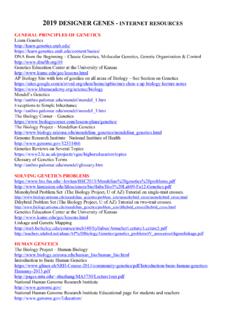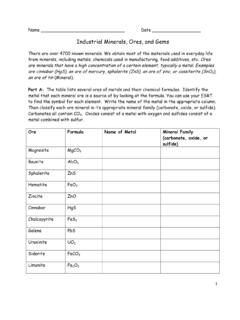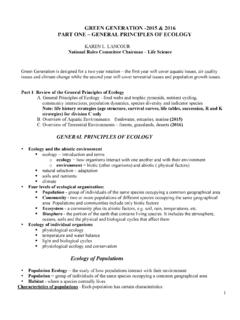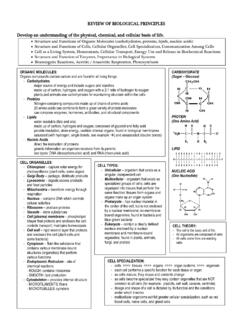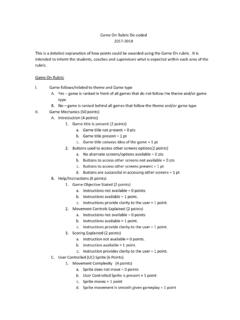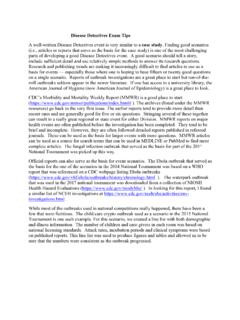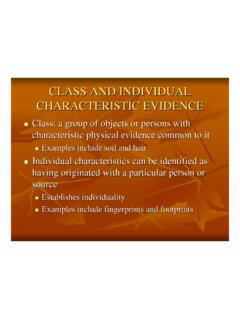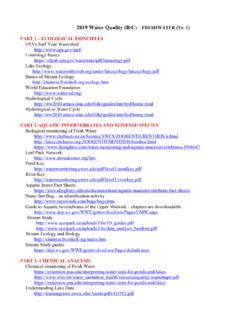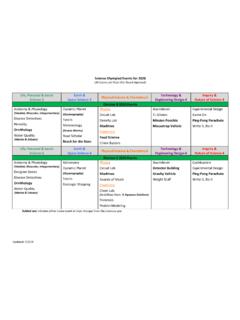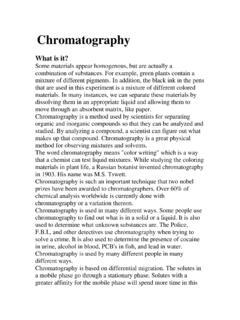Transcription of Problems in Mendelian Genetics
1 PRACTICE Problems IN Genetics PLUS SOLUTIONS Problems Involving One Gene 1. In cats, long hair is recessive to short hair. A true-breeding (homozygous) short-haired male is mated to a long-haired female. What will their kittens look like? 2. Two cats are mated. One of the parent cats is long-haired (recessive allele). The litter which results contains two short-haired and three long-haired kittens. What does the second parent look like, and what is its genotype? 3. Mrs. And Mr. Smith both have widow s peaks (dominant). Their first child also has a widow s peak, but their second child doesn t. Mr. Smith accuses Mrs.
2 Smith of being unfaithful to him. Is he necessarily justified? Why or why not? Work the Genetics problem predicting the frequencies of the versions of this trait among their prospective children. 4. Mr. and Mrs. Jones have six children. Three of them have attached earlobes (recessive) like their father, and the other three have free earlobes like their mother. What are the genotypes of Mr. and Mrs. Jones and of their numerous offspring? 5. Mr. and Mrs. Anderson both have tightly curled hair. (The hair form gene shows incomplete dominance. There are two alleles, curly and straight. The heterozygote has wavy hair.)
3 The Andersons have a child with wavy hair. Mr. Anderson accuses Mrs. Anderson of being unfaithful to him. Is he necessarily justified? Why or why not? 6. Two wavy haired people (one male and one female) marry and have eight children. Of these eight, how many would you expect to be curly haired, how many wavy haired and how many straight haired, assuming that the family follows the expected statistically predicted pattern? Suppose you examine the actual children and discover that three of the eight have curly hair. What do you suppose went wrong? 7. Basic body color for horses is influenced by several genes, on of which has several different alleles.
4 Two of these alleles the chestnut (dark brown) allele and a diluting (pale cream) allele (often incorrectly called albino ) display incomplete dominance. A horse heterozygous for these two alleles is a palomino (golden body color with flaxen mane and tail). Is it possible to produce a herd of pure-breeding palomino horses ? Why or why not? Work the Punnett s square for mating a palomino to a palomino and predict the phenotypic ratio among their offspring. 8. In certain portions of the Jewish population, there is a genetic disease called Tay Sachs disease, which is fatal to infants within the first five years of life.
5 This disease is caused by a recessive allele of a single gene. Why does this disease persist, even though it is invariably fatal long before the afflicted individual reaches reproductive age? (In other words, why doesn t the allele for Tay Sachs disease simply disappear?) 9. About 80% of the human population can taste the chemical phenolthiocarbamide (PTC), while the other 20% can t. This characteristic is governed by a single gene with two alleles, a tasting allele and a non-tasting allele. What does this statistic tell us about which allele (tasting or non-tasting) is dominant? 10. In fruit flies, the gene for wing shape has an unusual allele called curly (designated Cy ).
6 The normal (wild type) allele is designated cy. A fly homozygous for cy (cy cy) has normal, straight wings. The heterozygote (Cy cy) has wings which curl up on the ends (and, incidentally, can t really fly). The homozygote for the Cy allele (Cy Cy) never hatches out of the egg. In other words, this allele is lethal in the homozygous condition. If two curly winged flies are mated, and the female lays 100 eggs, predict the following, showing appropriate work: a. How many eggs will produce living offspring? b. How many straight winged flies do you expect among the living offspring? c. What percentage of the living offspring do you expect to be curly winged like the parents?
7 11. In cattle, there is an allele called dwarf which, in the heterozygote, produces calves with legs which are shorter than normal. This, again, is a homozygous lethal (the homozygous dwarf calves spontaneously abort early or a stillborn). If a dwarf bull is mated to 400 dwarf cows, what phenotypic ratio to you expect among the living offspring? Problems Involving Two Genes 1. A man with dark (dominant), curly (see problem ) hair marries a woman with light, straight hair. Their daughter, who happens to have dark hair, marries a man with light, wavy hair. Answer the following questions about this dark-haired daughter and her family.
8 A. Draw a Punnett s square for this marriage, and predict the phenotypic ratio among the offspring of the daughter and her husband. b. What is the chance that they will have a child with hair just like his or her father s? 2. In cats, again, black color is dominant to a special, temperature-sensitive albino gene which produces cats with dark legs, faces and tails (Siamese cats, in case you don t recognize it). A short haired (dominant) Siamese colored female is bred to a long-haired black male. They have eight kittens: 2 black, short-haired; 2 black, long-haired; 2 Siamese, short-haired; and 2 Siamese, long-haired.
9 What were the genotypes of the two parents? 3. Elizabeth is married to John, and they have four children. Elizabeth has a straight nose (recessive) and is able to roll her tongue (dominant). John is also able to roll his tongue, but he has a convex (Roman) nose (dominant). Of their four children, Ellen is just like her father, and Dan is just like his mother. The other children Anne, who has a convex nose, and Peter, who has a straight nose are unable to roll their tongues. Please answer the following questions about this family. a. What are the genotypes of Elizabeth and John? b. Elizabeth s father was a straight-nosed roller, while her mother was a convex-nosed non-roller.
10 What can you figure out about their genotypes? c. John s father was a straight-nosed roller, while his mother was a convex-nosed roller. What can you determine about their genotypes? d. Diagram the three described generations of this family in accepted pedigree form, including the phenotypes for these two traits. 4. If a pure-breeding (homozygous) black (dominant), long-haired (recessive) cat is mated to a pure-breeding Siamese, short-haired cat, and one of their male offspring is mated to one of their female offspring, what is the chance of producing a Siamese colored, short-haired kitten? 5. In horses , one which runs best in water (or in wet conditions) is called (WATER), and one which runs best in dry conditions is called (DRY).
